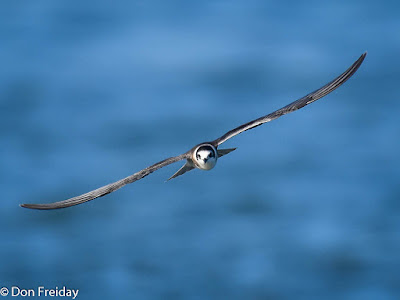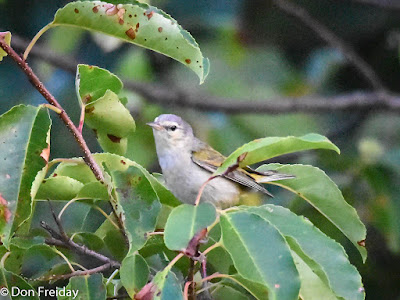[Click to enlarge photos.]
Adult shorebirds have been heading south since late June or early July, and now the juveniles - young of the year - are pouring through. There are plenty of adults still around, which leads to confusion, especially when using colors and patterns to identify the birds. How, for example, can the two birds above be the same species?
Well, they are, Least Sandpipers to be exact, which could have been told just by the yellow leg color and small size (unless you're trying for an exotic). Juvenile shorebirds, heading south with their first set of feathers, are usually well patterned and often quite bright. In many species, the patterning is formed in part by broad buff, white or orange edges to the upperpart feathers, created a scalloped efffect. On juveniles, the feathers are all the same age and in uniform, good condition. Thus we can say confidently that the left bird above is a juvenile.
A word of caution: juveniles of a given species can be variable one to the other. In particular, some are brighter than others, often because the bright ones have just come down from the nesting grounds and the feathers haven't had much time to show wear. We see lots of birders trying to create something exotic out of juvenile shorebirds because of this variability - there are bright and dull Semipalmated Sandpipers, Least Sandpipers, etc., so it is important to develop a feel for this variability.
The right bird above is an adult. Its feathers are not all the same age. The wing feathers are about a year old, while the body feathers were molted in last late winter and spring as the bird assumed breeding plumage. It is now in worn breeding plumage. The wing "panel" - the coverts - contrasts with the rest of the feathers because it is worn and uniform gray, compare it to the same place on the juvenile. I'm not seeing new, gray winter feathers coming in on this bird's body, so it is wearing worn breeding feathers. Since it is late August, this suggests this particular individual will winter in South America, and will molt when it gets there. If it were going to winter farther north, it would already be molting.

Another pair, this time Lesser Yellowlegs, adult on the left and juvenile on the right. The adult is in worn breeding plumage and does show new, winter-plumage gray feathers coming in on the back. The juvenile is neatly patterned with white spots on the edge of the upperpart feathers.
Both photos are from the South Cape May Meadows, NJ, the Least Sandpipers this week, the yellowlegs a couple weeks ago.














